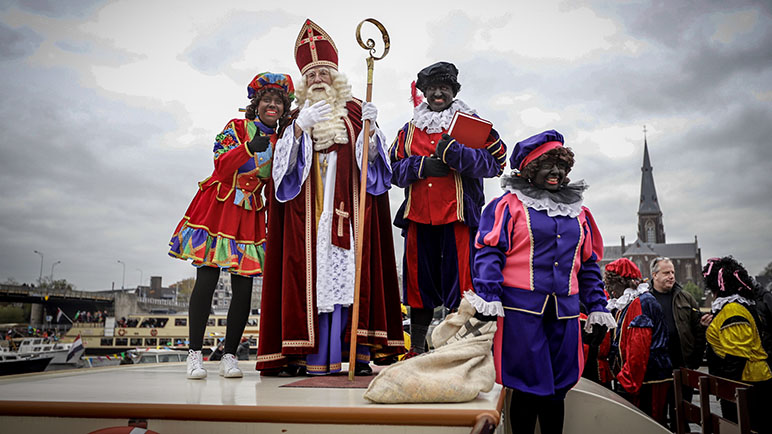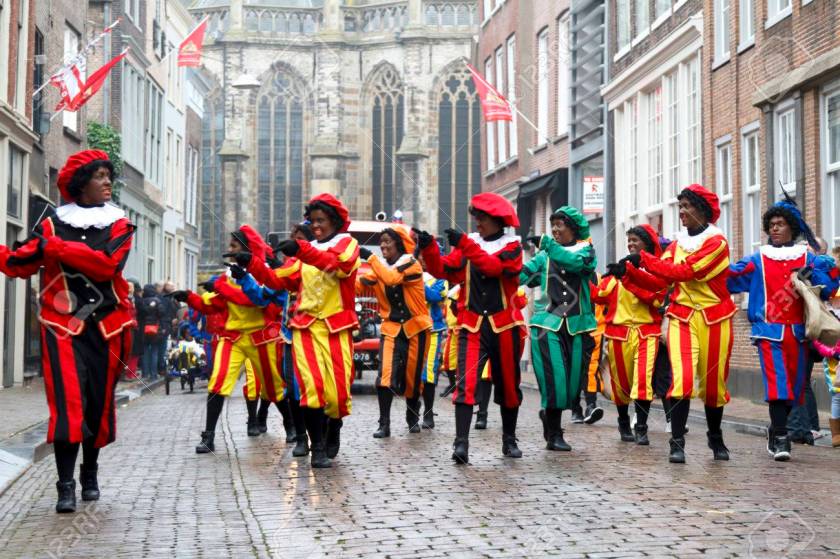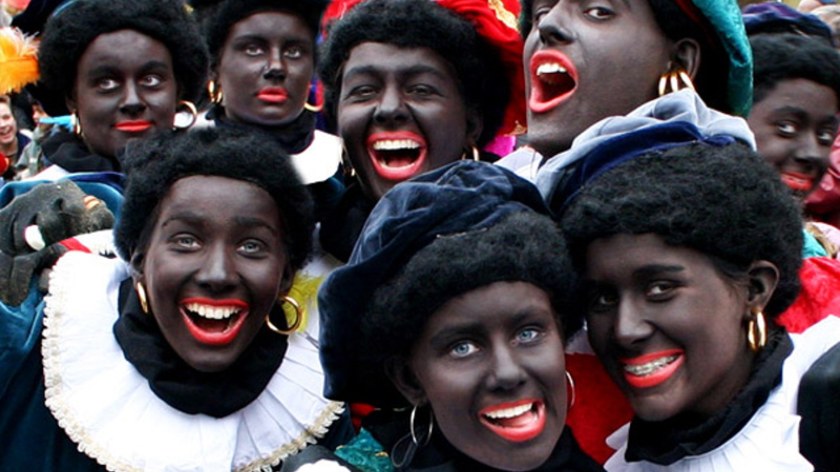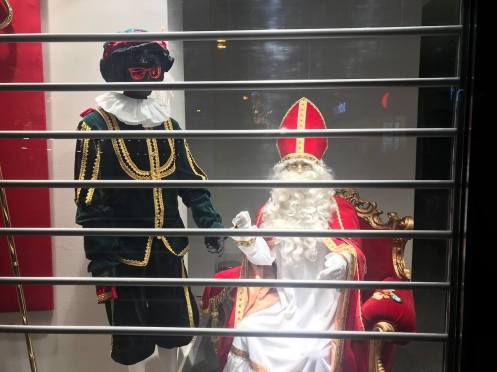
My wife just got back from the Netherlands. She had some agenda like seeing the family she lived with back in the day, going to museums, eating licorice, stroopwaffels, and vla, and other things that seemed trivial in comparison with my agenda for her: FIND ME ZWARTE PIET STUFF!
Turns out that was harder than she thought.

Now, if you don’t know who Zwarte Piet is, if you’re American, and/or you have a shred of social awareness, prepare to get uncomfortable. We’ll go with the neutral version first:
Zwarte Piet is Dutch for “Black Pete.” He’s a traditional character from the Sinterklaas (Saint Nicholas) story in the Netherlands and has been around since at least the 1850’s. The story goes that he’s a young “moorish” (sometimes) boy who helps Sinterklaas deliver presents on December 5th, the feast of Saint Nicholas. Stories differ, but a lot of parents say that it’s Piet who actually climbs down the chimney to leave gifts. And some say that he’s black not because he’s a “moor” but because of chimney soot. At parades during the holidays in the Netherlands, you’ll also see lots of people made up like him. Like this:

In Europe, it’s pretty common for Nick to have a companion. There’s Krampus, of course, but also Knecht Ruprecht, Belsnickel, Perchta, and other various “wild men” or “pagan” hangover figures. But Piet’s background is less innocent than theirs. In 1850, a Dutch teacher named Jan Schenkman wrote a book called Sint Nikolaas en zijn Knecht (“Saint Nicholas and his Servant”) that pretty much solidified his image and story. There had been other “pagan” characters following Nick in the Netherlands before then, but Schenkman’s version stuck. And it’s clear that he was drawing on images and accounts of continental aristocrats who had black slave boys or servants as a vogue in the early 1800’s. The costume that people now wear is specifically this kind of 19th century “servant” gear, and although there are a ton of people who point out that his history is actually much more complicated, Schenkman’s version won the day.

So it’s already a problem that Nick’s “servant” is a black child who is probably modelled on slaves. But hopefully anyone with even a shred of historical awareness in the U.S. knows about blackface. Granted, the Dutch don’t have the same sensitivity to that aspect in particular because it just wasn’t as big a part of their cultural history. But for us, to see a ton of white people dance around painted up like black “servants,” especially at Christmastime…well…yeah.

My wife found quite a few images of him while wandering around the smaller city where she spent most of her time.



He’s just a normal thing, part of advertisements, part of random holiday imagery, even showing up as a random piece of a Christmas shopping bag.

And her friends said that in the last few years, you can find “Piets” of all different colors. Not races — colors. Like Green Pete or Purple Pete. And that’s obviously trying to downplay the racial aspect but keep the tradition.

When she got to Amsterdam, though — nothing. Not a Piet in sight. Apparently The Hague is the same way. The bigger cities, where you have a more international population and, of course, more tourism, have played him down. And when he does show up, he’s changing: this year, Amsterdam’s “official” Piet will be a white guy with some soot on his nose.
At one dinner, one of her friends blamed “some American” for all the recent uproar over him. But even the United Nations got involved a couple of years ago, so it’s not like the obvious backlash against him is from a fringe group. And, besides, since Trump was elected, it turns out that a lot of far right groups in both Europe and U.S. have become his staunch defenders. Some cities are even worried about violence around him during parades and celebrations this year.

In truth, though, the Dutch are split on the issue, on both political ends. And that’s understandable. On the one hand, the character is the Saint of Children’s right-hand man, and he’s been around for at least 150 years. Of course people are going to defend him. At the same time…dude’s a slave. And they celebrate him in a way that, intentionally or not, is precisely the same way that white people used to mock black people while also trying to exploit their cultural contributions. (And if you don’t know much about blackface history, at least take a look at this site: http://black-face.com/. It also explains why a lot of the old cards I share are even more racist than you might initially think.)

My wife didn’t buy me a Zwarte Piet tree ornament. I’m not surprised. I don’t know that I would have put it on the tree, even ironically. I admit I love that there’s some seriously messed up holiday history out there. But I’m not going to celebrate it. Doesn’t mean I won’t keep showing you Zwarte Piet in all his problematic, offensive inglory, though… And, before you ask, Yes. These are real:



Black Pete isn´t modelled on slaves, in fact he´s not even modelled on black people. That´s a misunderstanding due to an explanatory urban legend about Saint Nicholas freeing slaves. That urban legend however has been made up not very long ago. Black Pete has a pagan origin and has been given a catholic explanation after Christianization. He has no connection to Blackface or racism.
I´m Dutch and have researched Dutch traditions for almost 30 years. You can read an article about the history of the Sinterklaas tradition, the origin of Black Pete and the meaning of his black colour at https://bertvanzantwijk.wordpress.com/2016/10/29/zwarte-piet/. The article is written in Dutch, but since your wife is Dutch that shouldn´t be a problem.
LikeLike
By the way… You write that a few years ago even the United Nations got involved in the discussion about Black Pete. That´s not true. A lady, Verene Shepherd, wrongly claimed to be speaking on behalf of United Nations and she said that Black Pete was racism. This lady is involved in a billions claim against all white countries for former slavery and has a financial interest in saying that Black Pete is racist.
LikeLike
Thank you for your post. Blackface has been a discussion in Canada too after a certain political leader’s old Halloween photos surfaced A very mainstream discussion. It’s now clear it is racism in Canada. Anyone masquerading as someone from another culture in an unflattering way, or that can be interpreted as doing so, is crossing a line. Dutch people being upset looks the same to me. Here’s what a folklorist says:
A very mainstream discussion. It’s now clear it is racism in Canada. Anyone masquerading as someone from another culture in an unflattering way, or that can be interpreted as doing so, is crossing a line. Dutch people being upset looks the same to me. Here’s what a folklorist says:
LikeLiked by 1 person
I agree with that. Doesn’t keep people every year from responding to this story with angry notes, that I usually just delete. The hard part, tho, is that the Dutch don’t have the same history with blackface that the other countries do. So in some ways, Black Peter is a bit of a casualty of globalization. At the same time, tho, he was always a servant (at best) and potential slave (at worst), and almost always a Moor. The whole thing about him just being dirty is wilfully ignoring all the history and books and traditions about him and, most likely, parents trying to avoid the racism when telling their kids why he looks like he does. Well intentioned, but not enough. But I totally get the resistance. It’s something they’ve grown up with. It’s in all their iconography, and it’s primarily groups of people from other countries that began the complaints, even though now there’s a much bigger call to get rid of him. So I think it is really important to be careful about why individual people still want him around rather than just labelling everyone in the Netherlands who isn’t on a crusade to get rid of him a racist because it’s just simple thinking and just as inaccurate as his defenders’ sense of history.
LikeLike